Judy and Punch is uneven, but packs a mighty wallop in its satire and visuals

The debut feature of Aussie director Mirrah Foulkes, Judy and Punch is unapologetically dark, funny, and feminist – if only it didn’t pull back in its third act and turn into a typical tale of revenge, writes Eliza Janssen.
How many good movies are there that are based on puppet shows? Apart from the (excellent) canon of Muppet movies, Judy and Punch might be the first feature film to draw directly from the art of puppeteering – in this case, the barbaric Elizabethan Punch and Judy marionette shows.
The tradition involves two performers, typically – a “bottler,” who draws in a captive crowd (and their money), and a “professor,” a puppeteer who uses crude wooden hand puppets or marionettes to tell the story of the vicious layabout Punch and his wife Judy. When Punch forgets to look after his infant child (or even accidentally grinds the baby into a string of sausages), Judy nags him, and Punch shuts her up by beating her to the point of unconsciousness with a big stick. You know, for kids!
In her feature film debut, Australian director Mirrah Foulkes chose this unlikely source material as the fuel for a fiery feminist yarn about the ways in which close-minded societies treat women: as “nags;” as whores; as witches to be stoned. In fact, Judy and Punch’s first ten minutes include a pretty brutal witch stoning, of which Judy (Mia Wasikowska) is the sole detractor.

She’s the archetypal “great woman behind every great man” – the bottler for her alcoholic husband Punch’s travelling marionette show. One of the film’s great achievements is in its broad understanding of repression, of how artistic, talented women can let themselves be kept in the wings by manipulative men, before that cruelty ever erupts as outright domestic abuse. Wasikowska brings a bottomless depth of sympathy and maturity to that role, making Judy more than just a victim.
Damon Herriman is the snivelling, egotistical Punch, one of his four (!) AACTA nominated roles from this year alone. While Punch collects praise as the front-man of the operation, it’s Judy who is the real talent behind the show. A warm, loving young mum and a stage magician, she worries to Punch: “You don’t think the show’s too Punchy, do you?”
Then the puppet show is brought brutally to life. When Punch’s ego and drunkenness result in tragedy, he beats Judy senseless and leaves her for dead in the woods. Luckily for Judy, this film is a cinematic fairy-tale of sorts – not the Disney kind, the Brothers Grimm kind, replete with a few artful amputations. So Judy is rescued by a “heretic’s camp” – a motley crew consisting of those whom the bigoted townsfolk would rather not acknowledge. Among the outsiders are veteran TV actors Virginia Gay and Gillian Jones, as well as heaps of Peter Pan-esque ragamuffin kids who are determined to get Judy back on her feet.
“Doesn’t that punchy guy always win?,” one of them asks Judy. And after she’s done her requisite amount of brooding, she replies, “He won’t be winning anymore.” From here on, Judy and Punch reverts into a somewhat familiar ‘revenge movie’ mode. As the radicalised, too-woke-for-Ye-Olde-times Judy, Wasikowska is given less to do in the film’s third act, perhaps because her character turns into something of a featureless super-heroine. It’s definitely on a more serious note than the opening act’s frivolous, ugly satire (“Happy stoning day!”, one repulsive local chirps) and consequently, less engaging.
Where the humour and logic of the plot sometimes give way to heavy-handedness, Judy and Punch’s rich visuals are consistently energising. The fictional town of Seaside (a landlocked mountain town) feels at once real and baroquely imaginative, with lush costume design and convincing 18th century locations. Use of Leonard Cohen’s Who By Fire and François Tétaz’s bonkers synth-driven score further flesh out the moody world of the film.
It’s a pity, then, that Foulkes resorts to a Big Convincing Feminist Speech to wrap all that eclecticism up with a neat bow – for such challenging subject matter, delivered with an otherwise sick sense of humour, Judy’s rousing third act solution to her problems feels too pat, predictable. Judy and Punch’s most admirable quality is in its ambition, and its refusal to settle down into a quiet depiction of female hardship in a brutal earlier time. That raucousness isn’t quite paid off once the film becomes a true revenge story, with plot elements that feel borrowed from other, simpler tales of empowerment.
Yes, the film’s conclusion doesn’t quite honour its startling opening act, which quite literally drew gasps from the screening I attended. But it’s also the only Australian film I’ve seen in a good while that elicited any kind of physical response from its audience (except, perhaps, Jennifer Kent’s The Nightingale – another period drama about a suffering young mother which stars Damon Herriman!). Whilst the film’s marriage of goofy comedy and horrific physical violence doesn’t always work, Judy and Punch’s final images certify Foulkes as an exciting storyteller and visual stylist to watch; they’re of Judy, and the new path she’s made for herself. Total artistic and personal freedom; no strings attached.
















